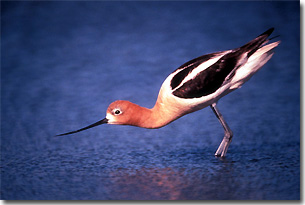
 |
||||||||||||
| Goals | Methods | Survey Sites | Enter Data | Query Data | Contact Us | Links | ||||||
|
Goals and Objectives 
American Avocet (USFWS) The Upper Mississippi Valley/Great Lakes (UMVGL) Regional Shorebird Conservation Plan (2000) advocated for extensive shorebird monitoring in the UMVGL region. The UMVGL plan followed delivery of the U.S. Shorebird Conservation Plan, which set broad goals for establishing a national shorebird monitoring program:
The USGS’s Western Shorebird Survey was created to monitor numbers of shorebirds at major stop-over sites, with specific survey areas chosen to include the most heavily used sites and any sites of special interest to local managers. The Wisconsin Shorebird Survey is not at this time a statewide program to monitor the state’s shorebird populations, although this may become a long-term goal of an evolving program. The goal of the Wisconsin Shorebird Survey will be to document shorebird occurrences during spring and fall at each of the 12 selected survey sites. The number of sites monitored in the future, however, will likely increase as the number of survey participants increase. Monitoring these 12 sites relates to a specific component of the UMVGL plan: “One of the most important issues consistently identified by wildlife managers surveyed in the UMVGL region was the need for basic information on shorebird use of their areas.” Accordingly, the Wisconsin Shorebird Survey has 2 primary objectives:
|